2 Women in Classical Greece and Rome
Focus Questions
- What was the status of women in Ancient Greece? What important roles did women occupy in the society?
- Ancient Greece had norms of self-government and democracy and also believed in a number of powerful female deities. Does these seem to be in contradiction to the status of women in Ancient Greece? If so, how do you explain this contradiction?
- How were women in Sparta a unique case compared to women in other Greek city-states? What explains Spartan women’s unusual circumstances?
- Ancient Greek and Roman cultures interacted, and Rome borrowed many things from Greek culture. But they were distinctly differenct cultures and societies. Give some examples of these differences.
- What status and roles did women hold in Ancient Roman society?
- Did women’s status and roles in Ancient Rome differ from those in Ancient Greece? If so, give examples.
- GIve some examples of specific significant women in Ancient Greece and Rome,
Women in Ancient Greece
Women in Mythology
Considering their limited role in actual society there is a surprisingly strong cast of female characters in Greek religion and mythology. Athena, the goddess of wisdom and patron of Athens stands out as a powerful figure blessed with intelligence, courage and honour. Again common to most ancient cultures where agriculture was crucial to the community, female fertility goddesses were extremely important and particularly venerated – Demeter and Persephone being the most revered for the Greeks.
As in other ancient male-dominated literature, women are often cast as troublemakers, from jealous Hera to Aphrodite employing her charms to make men lose their wits. Myths and literature abound with female characters trying their best to derail the plans of male heroes, from the supreme witch Medea to the deadly, if lovely, Sirens. They can also be represented as ruled only by wild passion and ecstatic emotion such as the Maenads. In contrast, the ideal chaste woman loyal to her absent husband is epitomised by Penelope in Homer‘s Odyssey. The Muses are another positive representation, celebrated not only for their physical beauty but also their wide-ranging skills in the arts. Whether these fictional characters had any bearing on the role of women in real life is an open question, as is the more intriguing one of what did Greek women themselves think of such male-created role-models? Perhaps we will never know.
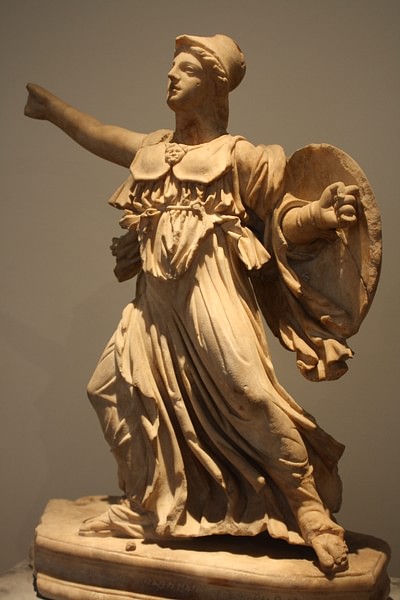
Girls
As in many other male-dominated and agrarian cultures, female babies were at a much higher risk of being abandoned at birth by their parents than male offspring. Children of citizens attended schools where the curriculum covered reading, writing, and mathematics. After these basics were mastered, studies turned to literature (for example, Homer), poetry, and music (especially the lyre). Athletics was also an essential element in a young person’s education. Girls were educated in a similar manner to boys but with a greater emphasis on dancing, gymnastics, and musical accomplishment which could be shown off in musical competitions and at religious festivals and ceremonies. The ultimate goal of a girl’s education was to prepare her for her role in rearing a family and not directly to stimulate intellectual development.
An important part of a girl’s upbringing involved pederasty (it was not only practised by mature males and boys). This was a relationship between an adult and an adolescent which included sexual relations but in addition to a physical relationship, the older partner acted as a mentor to the youth and educated them through the elder’s worldly and practical experience.
Young Women
Young women were expected to marry as a virgin, and marriage was usually organised by their father, who chose the husband and accepted from him a dowry. If a woman had no father, then her interests (marriage prospects and property management) were looked after by a guardian (kyrios or kurios), perhaps an uncle or another male relative. Married at the typical age of 13 or 14, love had little to do with the matching of husband and wife (damar). Of course, love may have developed between the couple, but the best that might be hoped for was philia – a general friendship/love sentiment; eros, the love of desire, was often sought elsewhere by the husband. All women were expected to marry, there was no provision and no role in Greek society for single mature females.

Mark Cartwright (CC BY-NC-SA)
Married Women
In the family home, women were expected to rear children and manage the daily requirements of the household. They had the help of slaves if the husband could afford them. Contact with non-family males was discouraged and women largely occupied their time with indoor activities such as wool-work and weaving. They could go out and visit the homes of friends and were able to participate in public religious ceremonies and festivals. Whether women could attend theatre performances or not is still disputed amongst scholars. More clear is that women could not attend public assemblies, vote, or hold public office. Even a woman’s name was not to be mentioned in public – for good reasons or bad.
Married women were, at least in the eyes of the law, under the complete authority of their husbands. Such writers as Aristotle have no doubts that women were intellectually incapable of making important decisions for themselves. In practice, of course, individual couples may well have shared their lives more equitably. Women were expected to be faithful to their husbands, but the reverse was not the case as husbands could freely engage the services of prostitutes, live-in lovers, and courtesans. Any woman who did not preserve the honour of the family (and so protect the legitimacy of the male line) was guilty of the serious crime of moicheia which would lead to her being banned from practising in public religious ceremonies. A husband who discovered that their wife was engaging in sexual relations with another man could murder the lover without fear of prosecution.
If a woman’s father died, she usually inherited nothing if she had any brothers. If she were a single child, then either her guardian or husband, when married, took control of the inheritance. In some cases when a single female inherited her father’s estate, she was obliged to marry her nearest male relative, typically an uncle. Females could inherit from the death of other male relatives, providing there was no male relative in line. Women did have some personal property, typically acquired as gifts from family members, which was usually in the form of clothes and jewellery. Women could not make a will and, on death, all of their property would go to their husband.
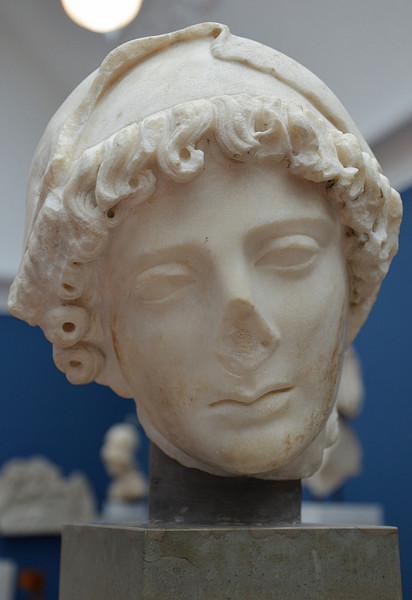
Carole Raddato (CC BY-SA)
Marriages could be ended on three grounds. The first and most common was repudiation by the husband (apopempsis or ekpempsis). No reason was necessary, only the return of the dowry was expected. The second termination cause was the wife leaving the family home (apoleipsis), and in this case, the woman’s new guardian was required to act as her legal representative. This was, however, a rare occurrence, and the woman’s reputation in society was damaged as a result. The third ground for termination was when the bride’s father asked for his daughter back (aphairesis), probably to offer her to another man with a more attractive dowry. This last option was only possible, however, if the wife had not had children. If a woman was left a widow, she was required to marry a close male relative in order to ensure property stayed within the family.
Other Roles
Women, of course, were also present in the various other non-citizen classes. As slaves, they would have performed all manner of duties and they would also have worked in businesses such as shops and bakeries. The group for which we have most information is that of sex-workers. Women were here divided into two categories. The first and perhaps most common was the brothel prostitute (pornē). The second type was the higher-class prostitute (hetaira). These latter women were educated in music (especially the flute) and culture and often formed lasting relationships with married men. It was also this class of women that entertained men (in every sense) at the celebrated symposium, the private drinking party for male guests only.
Finally, some women participated in cults and performed as priestesses to certain female deities (Demeter and Aphrodite especially) and also Dionysos. Priestesses, unlike their male counterparts, did have the added restriction that they were often, but not always, selected because they were virgins or beyond menopause. Worshippers, on the other hand, could be both sexes, and those rituals with restrictions could exclude either men or women. The Thesmophoria fertility festival was the most widespread such event and was only attended by married women. Each year in Athens, four young women were selected to serve the priestess of Athena Polias and weave the sacred peplos robe which would adorn the cult statue of the goddess. Perhaps the most famous female religious role was the aged Pythia oracle at Delphi who interpreted the proclamations of Apollo.
Bibliography
- Bagnall, R. et al. The Encyclopedia of Ancient History. Wiley-Blackwell, 2012
- Boys-Stones et al. The Oxford Handbook of Hellenic Studies. Oxford University Press, 2009.
- Hornblower, S. The Oxford Classical Dictionary. Oxford University Press, 2012.
- Kinzl, H. A Companion to the Classical Greek World. Wiley-Blackwell, 2016.
External Links
Love, Sex, & Marriage in Ancient Greece
by Ollie Wells
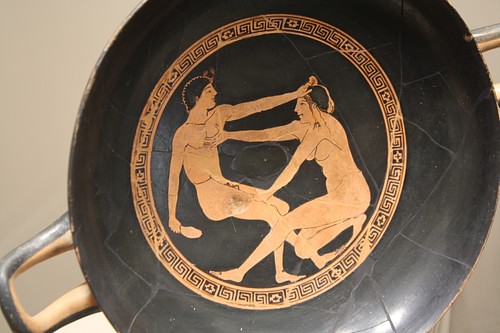
Marriage traditions in ancient Greece differed depending on the city-state, and majority of the sources, both literary and material, are about the upper classes. In upper-class families, marriage was seen as a way for the bride’s father to increase the wealth and social standing of the family, and love was rarely a factor. Women would usually get married in their early teens – though this was not the case in Sparta – and men would get married around their mid to late twenties. In Athens, where the majority of the written sources comes from, this was partly because they were expected to complete compulsory military service beforehand. Throughout the ancient Greek world, a fundamental element of the pre-marital arrangements was the dowry, in the form of money, land or anything else of value, arranged by the father of the bride to be given to the groom as part of the marriage agreement.
Marriage in Athens
The most commonly documented form of marriage ceremony in ancient Greek literature is the Athenian tradition. In the Greek tragedy Iphigenia in Aulis, the 5th-century BCE Athenian playwright Euripides describes the wedding preparations (or proaulia) for Iphigenia’s doomed marriage to Achilles:
Gather the baskets for the sacrifices, place wreaths on your head. You, too, Menelaos, get everything ready for this joyous occasion and let’s hear the flutes sing and the dancers pound the earth with their feet. (lines 432-436)
Sacrifices were an important part of the proaulia and so was music that accompanied the procession to the groom’s house on the day of the wedding. The sacrifices were made most commonly to Hera, as she was the divine example of a bride, and to Artemis, the goddess of virginity. The bride would have made sacrifices of animals and food, but, most notably, she would sacrifice her childhood clothes and toys as marriage marked the transition from childhood to adulthood. A 4th-century BCE inscription from Cyrene about purity regulations talks about the premarital sacrifices a woman must make to Artemis as though they are a penalty she must pay for the loss of her virginity.
The wedding day itself (gamos) was primarily focussed on the transference of the bride from her father’s house to her husband’s house. The day began with more sacrifices to the gods to ensure the marriage was blessed and with the bride bathing, a symbol of purity. The bride and groom then made sacrifices together at a temple before going to the home of the bride’s father for a wedding feast. However, the most important parts of the gamos took place in the evening when the groom would drive the bride in a chariot down a torch-lit path to his house, followed by their family and friends who bore gifts and played Greek music. When they arrived at the groom’s home the couple would be showered with dried fruits, a symbol of fertility, before the husband would lead his new wife to the bed chamber where her veil would be ritually removed.
The day after the wedding, relatives and friends would visit the home of the newlyweds to present them with gifts, such as furniture, pots, and jewellery. Many of these were decorated with domestic scenes, particularly depicting the domestic role in the household that the wife was now expected to fulfil. This day was called the epaulia.
Marriage in Sparta
In contrast to the weddings of Athens, Spartan marriage was certainly not a big affair involving family and friends. What traditions did exist were designed to be secretive and took place at night with the wife in disguise. Women were around the age of 18-20 and men were usually in their mid-twenties when they married. According to Plutarch in his Life of Lycurgus, in preparation for the marriage ritual, the bride would “cut her hair off close to the head” and “put a man’s cloak and sandals on” (book 15, section 3.) The bride would then be left in a dark room and the groom would ritually capture her. After this, husbands were supposed to visit their new wives in secret and at night.

Like the wedding traditions, the life of a Spartan wife after marriage also differed greatly from that of a wife in Athens. In Sparta, men were expected (under threat of being social outcasts) to spend the majority of their time either at war or with their comrades and were not allowed to live with their wives at all until they were 30. Due to this, the wife would have been the head of the household, taking on the responsibility to manage the land and helots (semi-enslaved agricultural labourers) given to the husband by the state. Such freedom and responsibility was not bestowed upon an Athenian wife, whose life was that of confinement. Despite their role in the daily running of the household, primarily raising children and making clothes, they were not by any means the head of the household and were, for the most part, prohibited from leaving the house without an escort. Though, in a rare similarity to Athens, bearing children was seen as the most important role of a woman in Sparta. Many of the laws for women codified by Lycurgus, Sparta’s legendary law-giver, were made to ensure that women would produce healthy children. One of these laws was making women participate in physical exercise to make them stronger for childbirth.
Family Life
In ancient Greece, having a family and raising children, particularly male, citizen heirs, was paramount. The 4th-century BCE Athenian statesman Demosthenes described a wife’s role in the family very bluntly in a statement saying that their job was to “bear us legitimate children and to be faithful guardians of our households” (Against Neaera, 59, 122.) It was seen as a wife’s duty to serve her husband and to ensure the upkeep of his property and the continuation of his line. In an Athenian family, the father was the head of the household (kyrios) who was legally responsible for and in control of his wife, children and unmarried female relatives. For these women, he would be responsible for arranging marriages and providing dowries. He even had the power to reject any child at birth that he did not wish to keep.
An Athenian wife was confined to her own part of the household, the Gynaeceum, where she would bring up her sons until the age of seven and teach her daughters how to make clothes, weave, cook, organise food, and manage slaves. Learning these skills was the upshot of an Athenian girl’s education, unlike her brother who would have engaged in formal education from the age of seven. This education was overseen by a pedagog, a slave who would take the son to school every day and keep the child’s father informed on his progress. The son would have learnt arithmetic, music, writing and reading, primarily Homer’s Iliad and Odyssey, which he would have been expected to memorise. This education usually ended at the age of 15, though those who did not have to work could join a gymnasium where they would further their studies in topics like science and Greek philosophy.
Divorce
In ancient Greece, the process of initiating divorce was a lot simpler for men than for women. In Athens, all the husband had to do was send his wife back to her father’s house and pay back her dowry. When a wife was found to have committed adultery, the husband was expected to divorce her to avoid legitimacy issues of a child born. For a woman, divorce was more complicated. Firstly, she needed to present her request in front of an archon (one of the chief city magistrates) then have the support of her father or closest male relative. The wife’s father also had the ability to force a divorce, (even if neither the husband nor the wife wanted it), if the marriage proved infertile. According to Herodotus in Book Six of The Histories, the same principle was followed in Sparta; infertility was grounds for a divorce.
Love in Ancient Greece
Throughout ancient Greece, romantic love was written about extensively in philosophy and poetry. So much so, that even the belief in soulmates that many people hold today was first being kindled in Plato’s Symposium. Love of this nature is not often talked about as existing within a marriage, and a lot of the discussion of romantic love in ancient Greece concentrates on its existence in the extramarital homosexual relationships that men had. Though, if the couple was lucky, love may have existed in marriage, even if it was not the reason for it. An example of love within a marriage being depicted in art can be interpreted from Philomelos and Plathane’s grave stele, which was found in the Kerimeikos and can be dated to the 5th century BCE. The relief on the grave marker shows the couple joining hands, a symbol of the lasting unity between the dead and their loved ones.
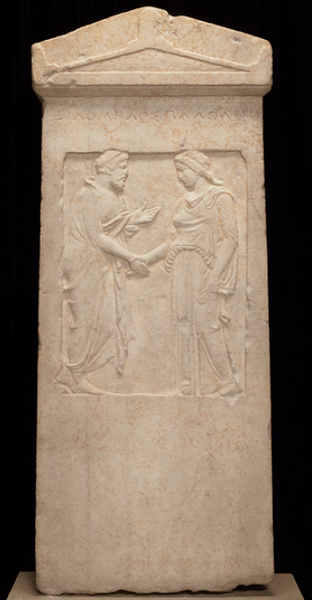
When discussing love in ancient Greece, a name that often comes up is Sappho (630- 570 BCE), the Greek lyric poet from the island of Lesbos whose writing on the women she loved and the heartbreak that ensued if her feelings were not reciprocated has made her one of the most famous names in ancient Greek literature. In an androcentric world, Sappho writes from a woman’s perspective on her love for other women, showing how much social constructs on what love was varied. Throughout her poetry, Sappho describes love to be both beautiful and painful depending on the state of the relationship. In fragment 94, for example, she is bidding her lover farewell when neither of them wants to leave the other:
Frankly I wish that I were dead:
She was weeping as she took her leave from me
And many times she told me this:
‘Oh what sadness we have suffered,
Sappho, for I’m leaving you against my will.’
So I gave this answer to her:
‘Go be happy but remember me there, for you know how we have cherished you,
If not, then I would remind you
[of the joy we have known,] of all
The loveliness that we have shared together;
For many wreaths of violets
Of roses of crocuses
… you wove around yourself by my side
… and many twisted garlands
which you had woven from the blooms
Of flowers, you placed around your slender neck
… and you were anointed with
A perfume, scented with blossom
… although it were fit for a queen
And on a bed, soft and tender
… you satisfied your desire…’
The desperate pain Sappho portrays in the first stanza and the conflicting emotion of wishing the one that hurt you well are very recognisable and timeless emotions. Sappho tells us that, even early on in the timeline of ancient Greek literature, an awareness existed of the intense and sometimes conflicting feelings that love causes. This is also famously shown in fragment 130 where she hails love as “bittersweet, undefeated creature – against you there is no defence.” This poem marks the first known use of the word ‘bittersweet’ (γλυκύπικρον) in literature.
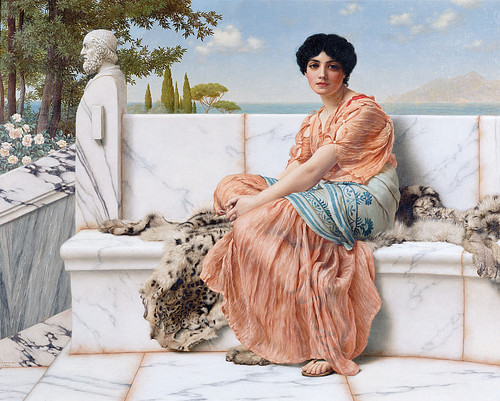
John William Godward (Public Domain)
In his Symposium, Plato also speaks of love as an overwhelming force that brings two people together. Plato mainly focusses on the pederastic relationships of classical Athens – relationships that existed between an adult male (the erastes) and a teenage boy (the eromenos). These relationships were a social norm amongst the upper class, and the role of the relationship was normally justified as educative, though a sexual element was certainly involved. Perhaps the most striking speech from Plato’s Symposium is Aristophanes’; it presents the idea of an innate force driving us to find our other half. Plato’s Aristophanes even goes so far as to discuss what the reaction to two people in love being physically melted and welded together would be. The story is a peculiar one, perhaps even written to be comedic, (as Aristophanes was a comic playwright), but its allusion to the idea of soulmates and having an ‘other half’ that is still very present in our society today.
Firstly, Aristophanes explains that a long time ago there were three sexes – male, female and androgynous – they were all round in shape with two sets of limbs and two faces. These early humans were powerful and they tried to attack the gods and so Zeus proposed reducing their strength by cutting them in half. Apollo healed the injury by closing it at the navel, but humans were now left with an even bigger wound and that was the loss of their other half. Each half now longed for the other. Zeus pitied them and invented sex as a solution. In this way, Plato also introduces the importance of sex in relationships and how this desire relates to love.
Sex in Ancient Greece
In ancient Greece, attitudes and views on sexuality differed greatly depending on gender. The sexuality of a woman was generally surrounded by stigma and suspicion, particularly in classical Athens, as their primary role in society was to produce legitimate children. The sexuality of a man, on the other hand, was treated very liberally. In Demosthenes’ Against Neaera, he states that “Mistresses we keep for the sake of pleasure, concubines for the daily care of our persons, but wives to bear us legitimate children and to be faithful guardians of our households” (59, 122).
For men, it was socially acceptable to partake in sexual relationships outside of their marriage. Men could both hire prostitutes and have concubines without being viewed as unfaithful. For instance, at symposia – a popular sort of party consisting of a banquet and entertainment – hetairai would often be employed. Unlike pornai (prostitutes who usually worked in brothels), a hetaira was a well-educated woman who could be hired by men, not only for sex but also for their skills in Greek dance, music, and conversation. Some men also chose to have pallakae (concubines), often slaves who the men would buy and take into their households.

Sebastià Giralt (CC BY-NC-SA)
Men could also partake in pederastic relationships. The ancient Greeks did not view sexuality or love in terms of gender as much as they viewed them in terms of power dynamics. Thus, the only aspect of a relationship that would bring about shame was being the passive partner in a relationship with another man. Pederastic relationships were usually approved by the eromenos’ father as these relationships were believed to play an important role in the education and initiation of an upper-class male into society.
Though extramarital affairs were normal for the men of ancient Greece, when it came to women, they were strictly condemned. The stress put on a woman’s fidelity in ancient Greece made her sexuality a topic that was talked about little and, due to this same reason, the ideal woman generally seems to be the one who lived her life in obscurity. Throughout classical literature, the fidelity that Penelope from Homer’s Odyssey presents is looked upon as being the hallmark of the ideal Greek woman. As she waited 20 years for Odysseus to return from the Trojan War, she turned away hundreds of suitors who were vying for her hand. The loyalty Penelope shows towards her husband in doing this and the lack of interest in other men is celebrated in the final book of the Odyssey. The ghost of Agamemnon speaks about her virtue’s fame as being immortal, and, from what we know of the attitudes towards a woman’s sexuality in classical Athens, we certainly see this ideal in place centuries down the line.
Bibliography
- Andrew G. Scott. “Plural Marriage and The Spartan State.” Historia: Zeitschrift Für Alte Geschichte, vol. 60, no. 4, 2011, pp. 413-424.
- Balmer, Josephine. Sappho. Lyle Stuart, 1988.
- BLUNDELL SUE. WOMEN IN ANCIENT GREECE . BRITISH MUSEUM, 1999.
- Chrystal, Paul. In Bed with the Ancient Greeks. Amberley Publishing, 2016.
- Demosthenes, translated by Norman W. DeWitt and Norman J. DeWitt. Against Neaera. 1949
- Dossier of purity regulations at Cyrene, accessed 15 Mar 2021.
- Euripides, translated by George Theodoridis. Iphigenia in Aulis. 2007
- Goldhill, Simon. Love, Sex & Tragedy. University of Chicago Press, 2005.
- Herodotus & Cartledge, Paul & Holland, Tom & Cartledge, Paul. The Histories. Penguin Classics, 2015.
- Homer & Robert Fagles & Bernard Knox. The Odyssey. Penguin Classics, 1999.
- Lena Larsson Loven and Agneta Stromberg & Lena Larsson Loven & Agneta Stromberg. Ancient Marriage in Myth and Reality. Cambridge Scholars Publishing, 2010.
- Oakley, John H. & Sinos, Rebecca H. The Wedding in Ancient Athens . Univ of Wisconsin Pr, 1993.
- Panos D. Bardis. “The Ancient Greek Family.” Social Science , 39(3), pp. 156-175.
- Plutarch & Perrin, Bernadotte. Plutarch Lives, I, Theseus and Romulus. Lycurgus and Numa. Solon and Publicola.. Harvard University Press, 1914.
- Rouse, W.H.D. Great Dialogues of Plato – The Republic – Apology – Crito – Phaedo – Ion – Meno.. Mentor Books, 2021.
- Thucydides, translated by J.M Dent and E.P Dutton. The History of the Peloponnesian War. 1910
- Xenophon, translated by William Heinemann. Symposium. 1979
Ten Noble and Notorious Women of Ancient Greece
Herodotus and other ancient Greek historians are far more likely to mention Persian queens than the wives of Greeks – not because Persian women were more powerful than their Greek counterparts, but because Persians had several wives, and so it was sometimes useful to record by which of them a certain Persian figure had been born. Since Greeks had only one legitimate wife, there was no need for such clarification when it came to prominent Greek citizens. (1)
Every so often, however, certain women performed deeds that the male writers of history simply could not ignore. Women such as Queen Gorgo of Sparta (l. c. 490 BCE) and Aspasia of Miletus (l. 470-410/400 BCE) have always been well known for their own achievements and for their association with famous men like the Spartan king Leonidas (r. 490-480 BCE) and the Athenian statesman Pericles (l. 495-429 BCE), but there were many more who led interesting lives and performed heroic acts and who remain lesser-known in the modern day.
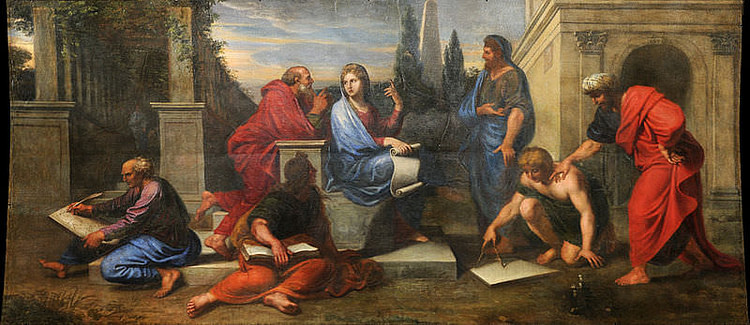
Except for dramatic or religious representations, women were usually absent from the accounts of ancient Greek historians. The following list, while clearly omitting many women of lasting importance, represents the few whose accomplishments could not be ignored by the patriarchal historians who recorded ancient Greek history. The female philosopher Hypatia of Alexandria (l. c. 370-415 CE) is only omitted from this list because she lived and worked in Alexandria, Egypt at a later date than the others. The present list includes:
- Hydna of Scione
- Anyte of Tegea
- Telesilla of Argos
- Phryne of Thespinae
- Arete of Cyrene
- Hipparchia of Maroneia
- Timycha of Sparta
- Philaenis of Samos
- Agnodice of Athens
- Thargelia of Miletus
Each of these women contributed significantly to the disciplines later associated with them or to culture generally even though their names have, in large part, been lost to history.
Hydna of Scione
Hydna of Scione (l. 5th century BCE) was trained to swim by her father, Scyllis of Scione, a diving instructor and expert swimmer who taught the art of swimming for a living. He instructed his daughter from a young age, and she became well known for her ability to dive deeply and swim long distances. When the Persians invaded Greece in 480 BCE, they sacked Athens and marched across the mainland after defeating the Greeks at Thermopylae.
The Persian navy then sought to destroy the rest of the Greek force in the naval battle at Salamis. If the Persians won at Salamis, Greece would be lost. Hydna and her father dove beneath the Persian ships and cut their moorings, causing these ships to drift and run aground or damage other vessels. This feat is even more impressive when one considers that, in order to perform it, Hydna and Scyllis had to swim ten miles into the sea in the middle of a storm. Their story comes from the Greek historian Pausanius in his Description of Greece, 10.19.1, and he further relates that, for their heroism, statues of them were erected at Delphi following the Persian defeat.
Anyte of Tegea
Anyte of Tegea (l. 3rd century BCE) was one of the female poets listed by Antipater of Thessalonica as one of the Nine Earthly Muses (with others such as Sappho of Lesbos and Telesilla of Argos). Anyte was among the first poets of Greece to emphasize the natural world in her work (as opposed to supernatural subjects such as the gods) and to write the epigram. She was best known for her epitaphs, especially those for animals.
These were not her only artistic contributions, however, and her poetry was so impressive that it was compared in ancient Greece to the works of Homer. Her epitaphs for pets were very popular, and she was much sought after to write them. An example is this one for a pet dog:
You died, Maira, near your many-rooted home at Locri, swiftest of noise-loving hounds;
A spotted-throated viper darted his cruel venom into your light-moving limbs.
Another poem is written as an epitaph for a locust and a cicada for whom a young girl constructed a tomb:
Myro, a girl, letting fall a child’s tears, raised this little tomb for the locust that sang in the seed-land and for the oak-dwelling cicada; implacable Hades holds their double song.
More of Anyte’s works survive in the present day than any other female Greek poet and are still admired as they were by her contemporaries. She is thought to have run a school for the study of poetry in the Peloponnesus though the exact location is unknown. Anyte was later attached to a legend in which it was said she once had a dream that the god of healing, Asclepius, told her to deliver a message to a man named Phalysius who was going blind.
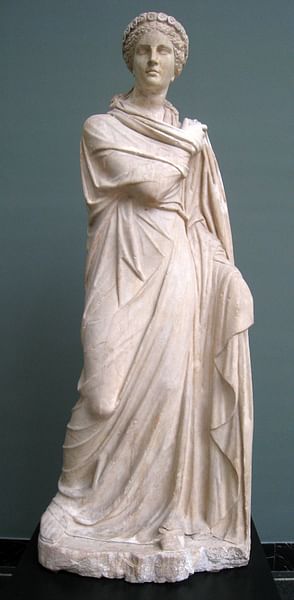
She woke and found a sealed writing tablet she had never seen before resting by her bed and, at her own expense, traveled a significant distance to deliver it to Phalysius. His eyes were healed, and when he opened the message, it instructed him to give Anyte 2,000 gold coins, which he promptly did. Whether there was any truth to the story is not as important as the message it would have imparted to its hearers: when the gods tell one to do something, one should do it.
Telesilla of Argos
Of the poets listed with Anyte in Antipater’s list of earthly muses is Telesilla of Argos (l. 5th century BCE) who, though famous for her poetry, became more so for defending her home city against the invading Spartans in 494/493 BCE. After Cleomenes I of Sparta (r. c. 519 – 490 BCE) decimated the Argive forces at Sepeia and, later, at the Sanctuary of Argus, he marched on the city of Argos. Telesilla took down the ornamental arms from temples in the city, raided the armory for whatever was left, and equipped a force of the city’s women with arms and armor. She then organized the city for defense and marched out to meet the Spartans, inflicting heavy losses.
Cleomenes recognized that he was facing an impossible situation: if he defeated her, he would have no honor in slaughtering women, while if they defeated him, Sparta would have been beaten by a band of girls, so he prudently withdrew his army, and Argos was saved. Modern-day historians still debate the truth of this account, but it was repeated by many ancient sources and is considered entirely plausible by a number of scholars today.
Phryne of Thespiae
Phryne of Thespiae (l. c. 370-c. 316 BCE) was a famous courtesan of Athens, best known for the court case she won by baring her breasts. Her actual name was Mnesarete (“commemorating virtue”), but she was called Phryne (“toad”) because of the yellow complexion of her skin. Ancient writers such as Athenaeus praise her extraordinary beauty, and she was the model for many artists and sculptors in Athens, including chiefly posing as Aphrodite (the existing statue, Aphrodite of Knidos, is thought to be modeled on her). The court case surrounded the charge of impiety, and it has been suggested that, whatever Phryne did, it had something to do with the Eleusinian Mysteries (initiation rites for the cult of Demeter and Persephone). It could be, like Alcibiades, that she had taken the sacred Kykeon (potentially psychoactive drink) for a private party with friends, but this is only conjecture (though, it seems, not out of character).
Her lover Hypereides, a famous orator, defended her in court and spoke eloquently, but it seemed as though the judges were going to condemn her. At this point, Hypereides disrobed Phryne, and the judges were so struck by her beauty that she was acquitted. The truth of this story, like that of Telesilla’s defense of Argos, has been debated for centuries. Some claim that the earliest account of the trial makes no mention of Phryne disrobing and that it was a later invention created to mock the Athenian court; some claim that it was Phryne herself, not Hypereides, who removed her clothes and that she also undid her hair to show herself in the likeness of Aphrodite.
Whatever happened, she was acquitted and went on living a life of luxury as one of the most beautiful and sought-after women of Athens. She became wealthy enough to live as she pleased and even offered to rebuild the walls of Thebes, which Alexander the Great had destroyed, if the people would consent to her inscription reading, “Destroyed by Alexander, Restored by Phryne the Courtesan”, but the Thebans refused her offer.
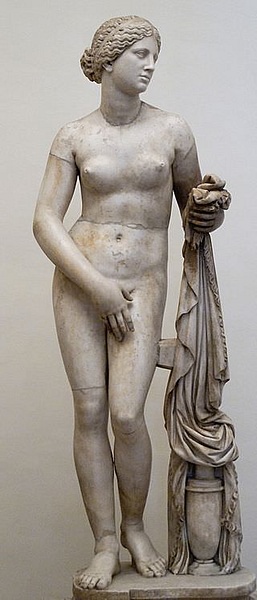
Marie-Lan Nguyen (Public Domain)
Arete of Cyrene
Arete of Cyrene (l. 4th century BCE) was a philosopher of the Cyrenaic School and the daughter of the hedonist philosopher Aristippus of Cyrene (l. c. 435-356 BCE) who grew up influenced by his teachings. There is some dispute among historians as to whether it was Aristippus or his grandson of the same name who founded the Cyrenaic School, but since ancient sources claim that Arete took over the school upon Aristippus’ death, it would appear to be the former.
Like her father, she is said to have held to the philosophy of “I possess, I am not possessed”, by which she meant that one could have as many worldly goods as one wished as long as one’s life was not controlled by those possessions. One could, for example, have a house and many beautiful objects furnishing and adorning it, but one should recognize such things as possessions which, perhaps, once belonged to another before and will certainly belong to someone else after one’s death or change in circumstance.
One should, therefore, pursue pleasure and enjoy the things of this world without allowing those things to control one’s life and freedom of movement. Arete of Cyrene is said to have written over 40 books, none of which survive in the present day. She also appears to have been a single mother who raised Aristippus-the-Younger in the hedonistic philosophy and home-schooled him. He would later take over the operation of the Cyrenaic School after Arete’s death.
Hipparchia of Maroneia
Another female philosopher was Hipparchia of Maroneia (l. c. 320 – 280 BCE), whose austere life and teachings stood in complete contrast to the hedonism of Arete of Cyrene. Hipparchia came to Athens as a teenager with her family and fell in love with the Cynic philosopher Crates of Thebes (l. c. 360 – 280 BCE) who lived there. Her brother, Metrocles (l. c. 4th century BCE), was one of Crates’ students and introduced them. Hipparchia was drawn to the simplicity of the Cynic lifestyle, which emphasized complete honesty, independence, rejection of luxury and pleasure, and living life in accordance with nature.
Hipparchia became so deeply attached to Crates himself that she rejected the suitors her parents encouraged and said that she would either marry Crates or kill herself. Crates was, at this time, an elderly man, and her parents asked him to convince Hipparchia to marry someone her own age and live a more traditional life. Crates is said to have disrobed before Hipparchia and said to her, “Here is the bridegroom and these are his possessions – choose accordingly”, which only made Hipparchia love him more.

Unknown (Public Domain)
They consummated the marriage in public on the porch of a building in downtown Athens. This was in keeping with the Cynic philosophy that one should shamelessly do in public what one does in private because, if there is nothing wrong with what one is doing, there should be no shame in performing the action in front of others. She wore men’s clothes and traveled and taught with Crates, bearing him two children.
When he died, she may have taken over teaching his students in Athens and was said to have written a number of books which are no longer extant. She is the only female philosopher included at length in Diogenes Laertius’ work The Lives and Opinions of Eminent Philosophers (3rd century CE) alongside men like Socrates and Plato.
Timycha of Sparta
Timycha of Sparta (l. 4th century BCE) was yet another female philosopher who traveled with her husband, Myllias of Croton, and a band of Pythagoreans. She became a symbol of courage in the face of adversity. The philosophy of Pythagoras emphasized the immortality of the soul and the sacredness of life and so Pythagoreans were strict vegetarians but were prohibited from eating beans. The precise reason for this is unclear, but it is thought that perhaps they believed that the shape of the bean, especially the fava bean, served as a conduit for souls to return to earth.
Reincarnation (known to them as the Transmigration of Souls) was a fundamental belief of the Pythagoreans, and it was thought that the souls of the living came back from the underworld through the earth and, especially, through bean fields. This knowledge, like most of Pythagoras’ teachings, was reserved only for those who were initiated into the mysteries and was not to be revealed to just anyone. One day, Timycha (who was six months pregnant at the time) and her band of philosophers were invited to the court of Dionysius the Elder to discuss their philosophy but, following the tenets of their belief, they rejected the tyrant’s invitation because they did not believe he was true in his intentions.
Dionysius, insulted, sent some of his soldiers to bring them forcibly to the court. The philosophers could have easily escaped by running through a nearby bean field but, because of their religious beliefs, they could not do this and so were all killed resisting the soldiers except for Timycha and Myllias. These two were captured and brought before Dionysius. He was intrigued when he heard they refused to enter the bean field to escape and questioned Timycha repeatedly. When she would not answer him, he had her tortured and then brought back to him where she is said to have bitten off her tongue and spat it out at his feet in defiance. What happened to her and Myllias after that incident is not known, but they were most likely executed. She was referenced by later Pythagoreans as a model of courage and martyr for the cause.
Philaenis of Samos
Philaenis of Samos (l. 4th century BCE) was a courtesan who became famous for writing a manual on lesbian sexual positions and the proper etiquette for courting a member of the same or opposite sex. Her work no longer survives but is cited by later authors. The term “lesbian” to denote a homosexual woman did not exist in ancient times and only originates later when people began to identify homosexual women with Sappho of the island of Lesbos because of her intimate female-oriented love poems (although, in fact, there is no other evidence that Sappho was homosexual).
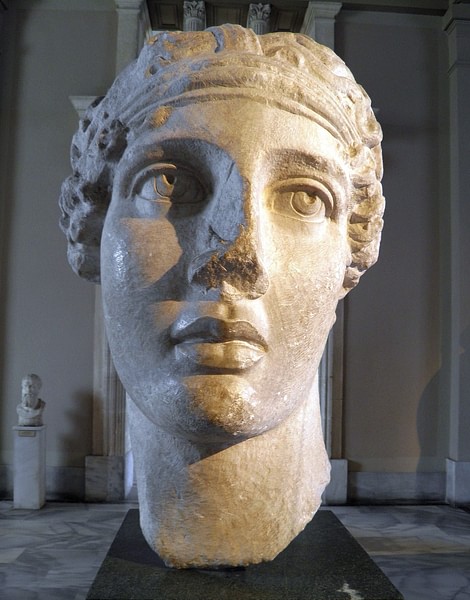
Carole Raddato (CC BY-SA)
In Philaenis’ time, a gay woman was known as a tribad (from the word “tribo” meaning “to rub, referring to women’s sexual activity with each other). Her work is said to have covered the best sexual positions, perfumes, cosmetics, means of inducing abortions, the art of kissing, and the art of seduction, including how to make successful passes.
Written in the style of The Histories of Herodotus – a kind of History of Sex – her book was very popular and widely read even though people seem to have publicly condemned it. Their disapproval had less to do with the subject matter than that a woman had written it. The writer Vicki Leon, author of Uppity Women in Ancient Times, writes:
Isn’t it always the case – the yearbook with your dorky picture survives for decades but the love-letters get thrown out! It was the same in ancient times: we have landfill amounts of dull material from dozens of male philosophers. But what about the works of steamy writer Philaenis? A bare nothing. And a real pity, too, because she gained notoriety for writing the first illustrated book on lesbian sexual matters – in verse no less. (185)
Agnodice of Athens
Philaenis’ work may have been considered scandalous at the time but not nearly as shocking as the life of Agnodice (l. 4th century BCE), who was the first female doctor in ancient Athens and whose challenge to the male-dominated profession changed the laws regarding women practicing medicine. Women had always been allowed to perform the services of midwives and could even attend patients until it was alleged that they were helping their female patients procure abortions. After that, women were not allowed to practice medicine, and the penalty for doing so was death.
Agnodice cut her hair and disguised herself as a man in order to study medicine and even traveled to Egypt, where women were held in higher regard and could be doctors, in order to learn her craft. Still in her guise as a man, she returned to Athens and began to treat people. She became so popular among female patients (who knew she was a woman) that she was accused by a group of men (who thought she was a man) of seducing them. She was put on trial in the Areopagus and, in defending herself against the charge, revealed she was a woman. The men then threatened to execute her for breaking the law by practicing medicine while pretending to be a man.
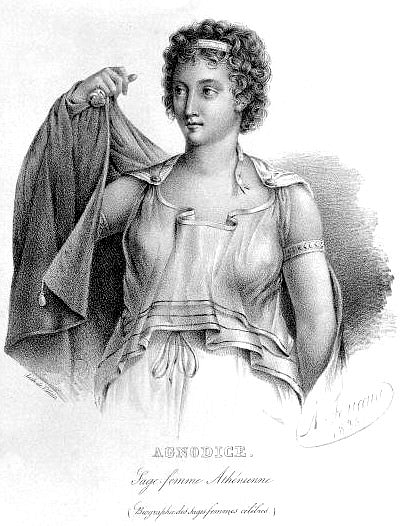
Missvain (Public Domain)
She was saved by her female patients who shamed the court into acquitting her. It seems as though they pointed out how Agnodice had been successfully practicing medicine for some time now and that the male doctors were simply jealous. After her trial, the laws were changed so that women could practice medicine equally with men.
Thargelia of Miletus
Another woman of note was the courtesan Thargelia of Miletus who, according to Athenaeus, was remarkably beautiful, clever, and charming. She was married 14 times in her life although the reason for, and duration of, these unions is not recorded. She was a pro-Persian Greek in an anti-Persian culture and, according to Plutarch, swayed many influential men to consider the Persian cause seriously during the time when Persia was moving to conquer Greece (480 BCE).
She was so seductive that, again according to Plutarch, no man could resist her and she was able to draw from the information which she then passed on to the Persians. Accordingly, she became known as a conspirator and enemy to the cause of Greek freedom, and her name was afterwards synonymous with “traitor” in the same way that the name of Benedict Arnold is in the modern day in the United States of America.
She lived in Thessaly and had many clients and, through them, she spread the Persian agenda throughout the region. She was the antithesis of women like Hydna of Scione or Gorgo of Sparta who risked their lives or lost their husbands in the cause of Greek freedom. At the same time, however, it should be noted that there were many Greeks who favored Persian rule, as it seemed more stable than the constant squabbling and fighting between the Greek city-states, and so it was not as though Thargelia was a lone voice for the Persian cause at the time.
Conclusion
There are many other impressive women of interest in the ancient histories of Greece who are also mentioned by the writers of their time. The athlete Pherenike of Rhodes, for example, disguised herself as a man in order to train her sons for the Olympics and the Spartan princess Cynisca hired men to drive the chariots pulled by horses she had trained, becoming the first woman to win at the Olympics Games.
Some women were able to rise above the restrictions society placed upon them (as in the case of Arete or Telesilla) and others were able to work within the system to live as they wanted to (such as Phryne and Thargelia). Although the ancient historians chose not to dwell on the accomplishments of women, these women had such an impact on their society that there was no way they could be ignored.
See also:
Bibliography
- Athenaeus Of Naucratis; Georgius [Georg] Kaibel (Ed. ). Athenaeus’ Deipnosophistae. B. G. Teubner, 1887.
- Diodorus Siculus. Histories. Harvard University Press, 1933.
- Gaius Julius Hyginus. Fabulae Romanae. Longman Publishing Group, 2014.
- Hipparchia: Internet Encyclopedia of Philosophy, accessed 1 Dec 2016.
- Leon, V. Uppity Women of Ancient Times. Fine Communications, 1998.
- Leonidas and Gorgo of Sparta by Helena P. Schrader, accessed 23 May 2021.
- Pausanias. Pausanias. Harvard University Press, 1935.
- Plutarch. Plutarch’s Lives Volume 1. Modern Library, 2001.
- Plutarch. Plutarch’s Lives, Volume 2. Modern Library, 2001.
- Snyder, J. M. The Woman and the Lyre. Southern Illinois University Press, 1991.
- The Poems of Anyte, accessed 1 Dec 2016.
- Waterfield, R. Herodotus: The Histories. Oxford University Press, 2008.
Questions & Answers
- There were many famous women of ancient Greece but among the best-known are Aspasia of Miletus, Sappho of Lesbos, Agnodice of Athens, Telesilla of Argos, and Hypatia of Alexandria.
- Women of ancient Greece became well-known by performing acts associated with males such as heroic military feats, literary compositions, philosophical works, or by exemplifying a virtue associated with femininity.
- Women’s rights in ancient Greece varied with each city-state. Women of Athens had very few rights while women of Sparta had far greater autonomy.
- We know about the accomplishments of women in ancient Greece through their own works or through references to them by male writers.
External Links

